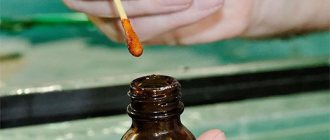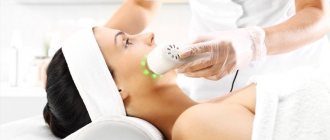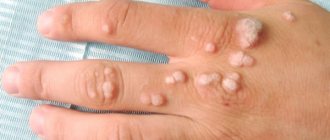Moles are a diagnosis that patients make for themselves. In medicine, there is a group of benign skin tumors with appropriate names, which are identified by doctors when patients come to them with “moles.” Most often, nevi of various varieties, angiomas (red moles), seborrheic keratosis, and dermatofibromas are detected. Much less often, melanoma or skin cancer is hidden under the guise of a “mole.” Before removing a mole with a laser, it is necessary to clearly determine the diagnosis. Sometimes, this requires dermatoscopy, scraping or even a biopsy.
Should moles be removed at all?
A mole needs to be removed only in two cases - if it causes physical or psychological discomfort. When a neoplasm is regularly injured during changing clothes or performing hygiene procedures, it is better to resolve the issue of removal for the sake of your safety. Moles on the face and other exposed parts of the body spoil the appearance and cause complexes and self-doubt. This problem especially worries young girls who always want to remain attractive and not think about how to disguise external defects. You should also remove moles that, without injury, have changed their shape and color, began to hurt and increase in size. It is advisable to remove moles that are located on the palms, soles of the feet, and scalp, where there is a high risk of injury. If you often go on seaside holidays, sunbathe a lot and have large moles on exposed areas of your body, you may want to consider removing them for your own safety. But only after consultation with a tumor removal specialist.
Examination of a mole before removal?
Before removing a nevus, it must be examined to exclude the malignant nature of the neoplasm (consultation with an oncologist, histology). Each mole that you want to remove on your own initiative should be at least visually examined. If the mole is on a hidden part of the body, small in size and completely small in size, you can simply observe it for a while. In any case, the decision to remove any skin growths should be made together with your doctor.
Preparations with a cauterizing effect
Pharmacological companies create various effective and affordable drugs for removing tumors at home. Cauterizing remedies for papillomas help get rid of growths forever. The following drugs can be purchased at the pharmacy:
- “Verrucacid.” It is an oily liquid whose main ingredient is phenol. The substance is quite aggressive. The liquid should be applied with an applicator exclusively to the neoplasm. Care must be taken to ensure that the product does not come into contact with healthy tissue. “Verrukatsid” is applied twice with an interval of five minutes. Usually one procedure is enough. The drug is contraindicated for the treatment of pregnant women and children under the age of seven.
- "Ferezol". This drug has a bactericidal and cauterizing effect. The liquid is applied pointwise, several times over the course of an hour. The procedure is repeated after eight days.
- "Solcoderm". This medicine contains oxalic, nitric, acetic and lactic acid. It is recommended to use the drug under the supervision of a specialist with higher or secondary medical education. “Solcoderm” is applied several times pointwise until the neoplasm takes on a yellowish or gray-white color.
Where can you check moles in St. Petersburg for malignancy?
If you have a problematic mole and would like to have it checked for malignancy and removed, please contact our clinics. Removal of tumors is carried out by experienced specialists who treat each patient carefully and responsibly - dermatocosmetologist, dermatologist, laser removal specialist, dermatologist-oncologist. Moles are tested for malignancy in the laboratory immediately after collecting the material. If you decide to remove a mole at the nearest beauty salon, they will not provide you with this service, which means there will be no opportunity to assess the nature of the neoplasm, which is very important when diagnosing cancer. Laser mole removal can be done in our clinics.
General characteristics of formations
Moles are brown pigmented growths. They are formed as the human body grows and develops. Additional factors for the appearance of nevi are hormonal levels, exposure to ultraviolet radiation, and genetics. Each mole contains melanin, a complex pigment that is responsible not only for color, but also for protecting the skin from sunlight.
Content:
- General characteristics of formations
- Types of nevi
- In what cases is it necessary to remove a mole?
- Contraindications to the procedure
- What you need to know about laser surgery?
- How is the removal done?
- Recovery period
- Possible complications and side effects
Most moles on the human body are not dangerous. The main thing is not to injure them, use sun filters and regularly conduct self-examination. But some pigmented formations can degenerate into melanoma. This is a malignant tumor that develops from melanocyte cells.
Melanoma is characterized by a rapid growth rate (cells rapidly divide and launch metastases throughout the body). The result is damage to organs and systems, which leads to irreversible consequences and death.
Is it possible to avoid melanoma? Yes, it is enough to conduct a self-examination and visit a dermatologist if one of the moles is suspicious. The only caveat is that melanoma cannot be removed using a laser. For this purpose, only surgical excision is used. If you notice that one of your moles has changed in color, size, or structure, contact your dermatologist immediately.
How is mole histology performed?
Thanks to histological examination, cancer cells can be detected even at the stage of their inception.
Indications for mole histology:
- redness of the skin around the tumor;
- small ulcers on the surface of the nevus;
- burning or pain in the mole area;
- change in color, size, shape of the tumor.
Histology is performed with the procedure of surgical excision of the mole. A small tissue sample is removed and sent for further examination. In the laboratory, biological material is placed in a special suspension and examined under a microscope. Diagnosis is based on the analysis of pigment-forming cells - melanocytes. Laboratory testing may take up to 14 days.
Types of nevi
Benign skin formations can be congenital or acquired. Nevi are also distinguished by shade, size, shape and surface texture. Congenital moles are conventionally divided into 4 categories based on size: small, medium, large and giant. Giant moles are extremely rare and occupy the entire anatomical area (for example, the chest or face).
Giant moles carry a hidden threat. The risk of nevus degeneration into melanoma reaches 50%. Patients with giant nevi should be regularly examined by a dermatologist to monitor the process and prevent degeneration in time.
Acquired formations are formed in early childhood. At this time, there is an intensive movement of melanocyte cells from the depths to the surface of the skin.
The number and location of moles is determined by genetic factors, exposure to ultraviolet radiation and general health.
There are only three types of acquired nevi.
The first of them is epidermal. This is the accumulation of a large number of melanocytes in the epidermis (the upper layer of the skin), which triggers the process of development of a flat miniature mole.
The second type is intradermal. Indicates an accumulation of pigment cells in the dermis (deep layers of the skin), which form convex, voluminous nevi. The third variety is borderline. This is a cluster of melanocyte cells at the border of the dermis and epidermis.
Are there any restrictions after mole removal?
A small crust forms at the site of the mole, which, after complete drying, comes off on its own, leaving clean, healthy skin in its place. Under no circumstances should this process be accelerated, because an unsightly scar may form in place of the crust. You should not sunbathe for a month after removing a mole. Before going outside, if it is an open area of the body, use a cream with SPF 50+, which provides a good level of protection against ultraviolet rays.
Restrictions that must be followed for 2-3 weeks after mole removal:
- Avoid contact with water
- Refrain from visiting baths, saunas, swimming pools, and open water bodies.
- The place where the nevus used to be must be protected from any thermal effects.
- Both natural and artificial tanning in a solarium are prohibited.
Is it safe to remove moles?
Today you can often see offers to remove moles using the laser method in a cosmetology office. For safety reasons, this is absolutely not worth doing. To carry out high-quality nevus removal, you should contact specialized medical institutions, where the procedure is performed by experienced medical workers. It is possible to immediately send the material for histological examination. Beauty salons do not provide this service. If a mole is suspected of being oncological, it is not recommended to use the laser method, which does not allow taking a tissue sample.
If the technology is followed, the nevus removal procedure is absolutely safe. The laser acts locally only on tumors, without heating neighboring organs and tissues.
What you need to know about laser surgery?
Laser surgery is one of the methods of performing surgical procedures. It involves removing/cauterizing small areas on the human body. The advantage of the method is minimal damage to surrounding healthy tissue and rapid restoration of the epidermis. For different types of operations, a specific type and power of equipment is used.
Laser surgery is used to correct vision, remove tumors, remove blockages in arteries, and excise pigmented formations.
Care after mole removal
Within 10-14 days after laser removal of a mole, you should pay attention to your health and follow all doctor’s recommendations.
What not to do:
- Always cover the scab with a bandage or plaster - this can slow down the regeneration process.
- Expose the skin to heat - do not go to the bathhouse or sauna, sunbathe in the sun, or make warm compresses.
- Be in direct sunlight - even after the crust falls off, you must apply sunscreen before going outside (if it is a visible part of the body).
- Play sports - regardless of the location of the mole, it is necessary to exclude physical activity for 1-2 weeks.
- Take a hot bath - on the first day after the procedure, you should not wet the mole with water at all. Next, hygiene procedures must be performed with water at room temperature. The ideal option is a shower. When taking a bath, there is a risk that after steaming the protective crust will fall off and an unaesthetic scar will appear in its place. You should also not rub the mole with a washcloth.
If a mole has been removed from the surface of the palms or soles, any physical activity should be reduced as much as possible. To treat the damaged area, use only medications recommended by your doctor. If you notice swelling, redness or pain in the area where there used to be a mole, do not self-medicate, but immediately consult a doctor.











